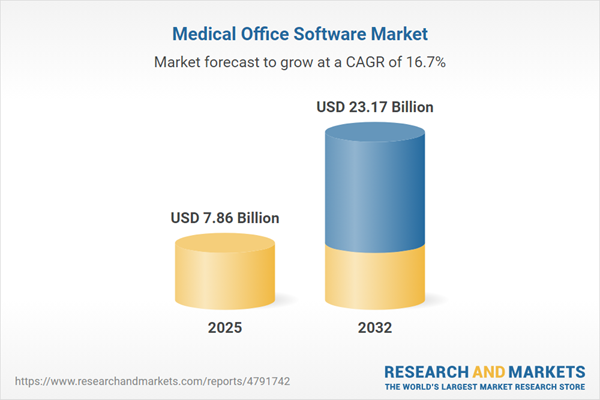Speak directly to the analyst to clarify any post sales queries you may have.
The medical office software market is advancing rapidly as healthcare organizations increasingly prioritize digital transformation to improve operational efficiency, compliance, and patient engagement. Senior decision-makers are accelerating adoption of technology solutions that not only optimize workflows, but also build resilient and adaptable healthcare delivery environments.
Market Snapshot: Latest Growth in the Medical Office Software Market
The global medical office software market is experiencing robust expansion, marked by accelerated deployment of cloud-native solutions and automation across core administrative and clinical operations. Increasing emphasis on platform interoperability and responsive system architectures is allowing healthcare organizations to keep pace with evolving regulatory frameworks and the rising digital expectations of both patients and providers. Enhanced technology standards and upgraded infrastructure have enabled secure data management and more consistent compliance procedures, while reducing administrative burdens. As these foundational improvements take hold, organizations are using them to foster departmental collaboration, streamline processes from check-in to claims, and implement scalable systems capable of meeting shifting industry requirements in real time.
Scope & Segmentation of the Medical Office Software Market
- Product Types: Electronic health records ensure structured healthcare documentation; medical billing applications support accurate transactions; and practice management suites provide unified solutions for administrative efficiency and revenue cycle visibility.
- End Users: Clinics, hospitals, diagnostic centers, laboratories, and specialty practices—including cardiology, dental, and ophthalmology—require software tailored for their clinical workflows and compliance processes.
- Delivery Modes: Client-server, web-based, and mobile deployments integrate with diverse healthcare IT landscapes, giving organizations flexibility for centralized management, remote access, and multi-site collaboration.
- Organization Sizes: Platforms are designed to adapt to the evolving needs of both small practices and large health systems, supporting scalable workflows as organizations expand or redefine strategic objectives.
- Deployment Types: Cloud-based and on-premise installations allow organizations to align technology choices with data privacy, security, and governance priorities important for safeguarding sensitive information.
- Regional Coverage: The Americas, Europe, Middle East and Africa, and Asia-Pacific each demonstrate unique adoption drivers, influenced by local healthcare maturity, compliance focus, and infrastructure capabilities.
- Key Companies: Epic Systems Corporation, Oracle Corporation, Medical Information Technology Inc., athenahealth Inc., Allscripts Healthcare Solutions Inc., eClinicalWorks LLC, NextGen Healthcare Inc., Greenway Health LLC, AdvancedMD Inc., and Kareo Inc. deliver platforms that strengthen interoperability and workflow agility across both general and specialty care environments.
Key Takeaways for Senior Decision-Makers
- Adopting cloud-based and interoperable platforms supports evolving regulatory demands while addressing cybersecurity and privacy goals across the organization.
- Integrated software solutions reduce departmental silos, enhance collaboration, and provide decision-makers with actionable real-time insights for improved care strategy and resource allocation.
- Partnering with knowledgeable vendors streamlines technology adoption, ensures fit with diverse workflows and jurisdictional requirements, and helps mitigate risk during transition phases.
- Customizable and scalable tools enable organizations to respond swiftly to compliance changes and market pressures, improving regional and international expansion initiatives.
- Regular collaboration between solution providers and healthcare organizations helps maintain adherence to compliance standards and operational expectations through timely updates and ongoing support.
Tariff Impact on Cost Dynamics and Operational Strategies
Shifts in United States tariffs have contributed to increased licensing and hardware costs for healthcare providers. In response, organizations are managing spend by utilizing domestic data centers and increasing cloud capacity to control operational budgets. Careful vendor negotiations and strategic procurement practices help align technology investments with cost management objectives. Additionally, regional software customization by vendors empowers healthcare organizations to navigate variable technology supply, adapt to unique business environments, and sustain critical operations.
Methodology & Data Sources
This report incorporates comprehensive secondary research, direct interviews with healthcare executives, and structured benchmarking of vendors. Expert-facilitated industry workshops and scenario analysis inform actionable recommendations supporting ongoing technology transformation and digital adoption among healthcare providers.
Why This Report Matters
- Aligns software acquisition strategies with health system compliance demands and evolving digital transformation requirements, underpinning future organizational competitiveness.
- Offers actionable segmentation and workflow analysis, empowering leaders to allocate resources efficiently and drive outcomes aligned with business goals.
- Equips senior executives with foresight to anticipate obstacles and leverage new strategic opportunities in healthcare IT implementation.
Conclusion
This report provides succinct, evidence-based guidance for executives seeking to streamline operations, guide technology adoption, and successfully navigate the healthcare software market’s dynamic landscape.
Additional Product Information:
- Purchase of this report includes 1 year online access with quarterly updates.
- This report can be updated on request. Please contact our Customer Experience team using the Ask a Question widget on our website.
Table of Contents
3. Executive Summary
4. Market Overview
7. Cumulative Impact of Artificial Intelligence 2025
Companies Mentioned
The companies profiled in this Medical Office Software market report include:- Epic Systems Corporation
- Oracle Corporation
- Medical Information Technology, Inc.
- athenahealth, Inc.
- Allscripts Healthcare Solutions, Inc.
- eClinicalWorks, LLC
- NextGen Healthcare, Inc.
- Greenway Health, LLC
- AdvancedMD, Inc.
- Kareo, Inc.
Table Information
| Report Attribute | Details |
|---|---|
| No. of Pages | 192 |
| Published | November 2025 |
| Forecast Period | 2025 - 2032 |
| Estimated Market Value ( USD | $ 7.86 Billion |
| Forecasted Market Value ( USD | $ 23.17 Billion |
| Compound Annual Growth Rate | 16.6% |
| Regions Covered | Global |
| No. of Companies Mentioned | 11 |









